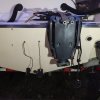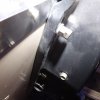- Joined
- Apr 30, 2015
- Messages
- 157
- Reaction score
- 30
- Points
- 28
I replaced my Bang Cap with 1/16" Stainless while I had the motors off. The brackets did mash down against the old aluminum Bang Cap,and there was some corrosion but not really bad. I dry fitted the brackets before caulking, and the gap is noticable. I haven't cranked the bolts hard yet, just with a light impact. Question is, would you just torque them down and make sure the gap is sealed with caulk, or cut the Bang Plate so the bracket is flat against the transom?






